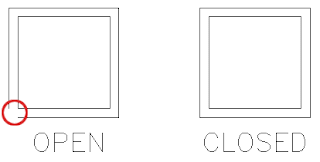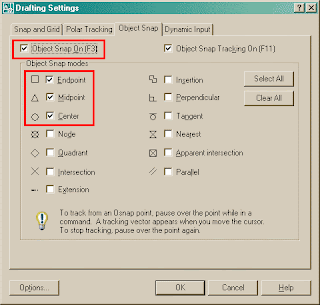Topics covered in this Lesson:1-3
Rectangle | Multi Line | Extend | Offset | Trim | Introduction to Object Snaps
The purpose of this assignment is to use the commands learned in the previous lesson and learn some new ones.
Duplicate the drawing called Assign_2.
Click HERE to download the DWG file.
Once again, do not worry about title blocks, text or dimensions, draw only what is in yellow.
Start AutoCAD and begin the the drawing by opening up the template file like you did in
Draw a LINE from 1,2 to 3,2 to 3,4 to 1,4 (*Remember to watch the command line as you do this.) For the last line, you can either type in 1,2 or C to close the line back to the first point you entered. These are absolute co-ordinates. Make sure you understand what the points your just entered represent.
Draw the next square using the RECTANGLE command. A rectangle is created by specifying 2 points to represent the opposite corners. Enter the first point as 4.5,2 and then make the opposite corner 2 inches over and 2 inches up @2,2 using relative co-ordinates. This is much faster and also makes the square one object and not 4 separate lines.
ERASE the rectangle. You will see that all of it is gone with one pick. Redraw it and continue.
Draw the third box using the MULTILINE command. This box is 1-1/2" square. The following steps are what you will see on the command line. Before drawing the lines, you have to set the SCALE to 0.15"(distance between the lines) by typing 'S'. Then set the JUSTIFICATION (offset origin) by typing 'J'.
Command: ml
 This is an example of why you have to look at the command line as you work. As soon as you start the command, you have choices available. Whenever you see this come up, if you want to change anything, you just type the CAPITAL letter of the option. For example, if you want to undo the last point, you would type u at this point. For this assignment you only changed the scale. After you have completed the assignment, try different settings for this command. Use your AutoCAD help option to see what these options control. (NOTE: I don't normally use Multilines while drawing as I don't have complete control over both the inner and outer lines. On the other hand, Multilines can be great for drawing quick offset lines. Also, they cannot be trimmed (you have to explode them first).
This is an example of why you have to look at the command line as you work. As soon as you start the command, you have choices available. Whenever you see this come up, if you want to change anything, you just type the CAPITAL letter of the option. For example, if you want to undo the last point, you would type u at this point. For this assignment you only changed the scale. After you have completed the assignment, try different settings for this command. Use your AutoCAD help option to see what these options control. (NOTE: I don't normally use Multilines while drawing as I don't have complete control over both the inner and outer lines. On the other hand, Multilines can be great for drawing quick offset lines. Also, they cannot be trimmed (you have to explode them first).Draw a line from 2,5 to 2,6.5 Draw another line from 1,6 to 3,6 You should now have two perpendicular lines. What you want to do is trim off the top of the vertical line and create a T.
Start the TRIM command. It will first ask for a cutting edge. Select the horizontal line and press
Object Snaps
Suppose you want to draw a line from the center of the circle to the middle of the vertical line you extended earlier. AutoCAD has a feature that makes this very easy. These are the Object Snaps (or Osnaps "Oh-Snaps"). Type OS
 You may also see a toolbar with these Osnaps as shown below.
You may also see a toolbar with these Osnaps as shown below.
 You may select whichever points you want to 'snap' on an object. Here is a list of your options. Followed by the command entry to invoke the needed Osnap.
You may select whichever points you want to 'snap' on an object. Here is a list of your options. Followed by the command entry to invoke the needed Osnap.Endpoint - snaps to either the beginning or the end of an object such as a line - END
Midpoint - snaps to the exact middle of a line or an arc - MID
Center - snaps to the center-point of a circle or arc - CEN
Node - snaps to 'nodes' (not covered in this course) - NOD
Quadrant - snaps to any of the four quadrants of a circle - QUA
Intersection - snaps to the point where two object cross - INT
Extension - Snaps to the phantom extension of an arc or line - EXT
Insertion - snaps to the insertion point of an object (such as a block or text) - INS
Perpendicular - will snap so that the result is perpendicular to line selected - PER
Tangent - snaps to create a line tangent to a circle or arc - TAN
Nearest - will find the closest point an object and snap to that point - NEA
Parallel -Snaps parallel to a specified line - PAR
None - temporarily turns off all Osnaps. (Pressing your F3 Key is quicker) - NON
Osnap settings - opens the Osnap dialog box.
Temporary Tracking - Creates a temporary tracking point (see Object Tracking).
From - Allows you to select a point, then denote a new location 'from' that point using relative co-ordinates. This can save you the time of drawing (and erasing) construction lines.
M2P - This isn't technically an 'Object Snap' as you are not snapping to an object, but it allows you to select 2 points and it will calculate the midpoint between those 2 points. This is a very handy option to have.
Note: Beside each checkbox is a symbol. That symbol will show up on the screen when you have found a valid snap point. (An endpoint will show a small square). If you select the "Options" button, you can change the aperture size and the color of the Osnaps. Depending upon the background you are drawing on, this may be needed.
1.Check off the boxes as shown in the dialog box above (Object Snaps On, Endpoint, Midpoint, Center) and press OK.
2.Begin the LINE command. Move your cursor around the screen and you'll see that as you get close to an object, it will 'snap' to one of the points that you had checked off in the dialog box. Place your cursor on the circle (not the middle of the circle) until you see a small purple circle appear at its center. Left-click to make this the start point of the line. Move the cursor towards the middle of the vertical line until you see a small triangle appear. (Remember this is the symbol for 'midpoint'). When you see it left-click to accept this as your endpoint. Press to end the line command.
3.Save your drawing.
4.Print your drawing with the same settings as in Assignment #1.
TIP: Before you select the Osnap you want, you can press the TAB key on your keyboard to cycle through the available Osnaps in the area of your cursor.
CAUTION: Although it may seem tempting to turn 'all' the Osnaps on when drawing, you can have too much of a good thing. For example, in shorter lines, Midpoint, Nearest and Perpendicular could all be very close to each other, and you could select the wrong point.
When you have finished the assignment, continue practicing with the commands until they are mastered. These are common commands that you will use in everyday drafting.
Extra Practice: Copy this drawing, using lines, mlines, offset, osnaps - extra_003.gif
Extra Practice: Copy this drawing, it could a little to figure out, but still uses the commands you have learned so far. - extra_004.gif
Extra Practice: Have a look at this drawing of a simple reflected ceiling plan (RCF) and see how the offset, trim and extend commands might be used. If you know how to change units to Architectural, try drawing it.

0 comments:
Post a Comment